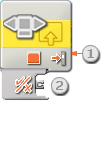當指定的NXT按鍵被按下後,設定好這個指令後,就會透過資料線傳送"真"值.This block outputs a “true” signal through a data wire when one of the NXT buttons is activated. You will have to select the button and the action that will send the “true” signal.

- 指令下方的圖樣顯示哪個NXT按鍵被選擇.
The icon at the bottom of the block indicates which NXT button has been selected. - 當指令放在工作區時,資料集線器會自動打開.至少必須使用一條輸出資料線來傳遞數據到其他的指令.(參閱下方的資料集線器資訊)
The block’s data hub will automatically open when the block is placed on the sequence beam. You will need to drag a data wire from the NXT Buttons block to another block that can accept a logic (true/false) signal. (See the Data Hub section below for more information.)
設定NXT按鍵指令
Configuring the NXT Buttons Block

- 選擇哪個NXT按鍵被按下時會送出"真"值.
Select which NXT button will send out a “true” signal when activated. - 觸碰表示會在NXT按鍵被快速地按下與釋放後繼續執行.按下表示指令會在NXT按鍵當時被按下後繼續執行.釋放表示指令會在NXT按鍵當時被釋放後繼續執行.Choose Bumped if you want the NXT button to be activated after a quick press and release. Choose Pressed if you want the button to be activated at the instant the button is pressed in. Choose Released if you want the button to be activated at the instant the button is released.
- 當NXT按鍵被觸碰,按下,釋放時,回饋區會顯示"1".
The feedback box will display a “1” when the chosen NXT button is bumped, pressed or released (according to the configuration you’ve set).
設定NXT按鍵指令的資料集線器
Configuring the NXT Buttons block’s Data Hub
用資料線可以任意地用來控制NXT按鍵指令.(從其他指令的資料集線器到NXT按鍵指令的資料集線器).
You can control the NXT Buttons block dynamically by connecting data wires (from other blocks’ data hubs) to the NXT Buttons block’s data hub.
把指令放在工作區上後,可以按圖示的左下角來打開資料集線器.
Open a block’s data hub by clicking the tab at the lower left edge of the block after it has been placed on the work area.

連接到集線器左邊連接埠的資料線是屬於負責傳遞資料進入指令中,而要從指令送出資料時,則須從集線器的右邊連接埠連接資料線.
Data wires carrying input information to a block are connected to the plugs on the left side of its data hub. Data wires carrying output information are connected to the plugs on the right side.

[A]輸入連接埠 [A] Input plug
[B]輸出連結部 [B] Output plug
[C]數字資料線(黃) [C] Number data wire (yellow)
[D]邏輯資料線(綠) [D]Logic data wire (green)
[E]文字資料線(橘) [E]Text data wire (orange)
[F]無效資料線(灰) [F]Broken data wire (gray)
資料由輸入端傳至傳出端
Passing from the input plug to the output plug
如果輸入連接埠有對應的輸出連接埠(請參閱 A 以上)時,那麼輸入的資料就會原封不動地傳遞到輸出連接埠.在這樣的情況下, 如果輸入連接埠連著資料線,那麼就只能使用輸出連結埠來做連結. 也就是說,當連結輸出連接線到這樣的輸出連接埠,而不透過相對應的輸入資料線時,就會讓該輸出連接線呈現無效的狀態.
If an input plug has a corresponding output plug (see A above), the input data will pass through from the input plug to the output plug without being changed. In this case, you can only use the output plug if the input plug is connected to an input data wire; connecting an output data wire to such an output plug without a connected input data wire will cause the output data wire to be “broken” (and colored gray).
特定的資料型態
Data wires carry specific types of data
每條資料線都負責傳送特定資料.例如,一條從邏輯連接埠拉出的資料線則只能連結到另一個同屬邏輯連接埠的集線器上.
Each data wire carries a specific type of data between blocks. For example, if a data wire is dragged from a logic plug on a block’s data hub, it can only be connected to a logic plug on another block’s data hub. The chart below shows what kind of data each plug can accept or send out.
資料線顏色
Data wire colors
資料線依照特定的顏色作識別:黃色資料線傳送數值資料、綠色資料線傳送邏輯資料(真/偽)及橘色資料線傳送文字資料
Data wires are identified with specific colors: wires carrying number data are colored yellow, wires carrying logic data are colored green, and wires carrying text data are colored orange.
無效的資料線
“Broken” data wires
如果資料線連結到錯誤資料型態的連接埠時,則該資料線會呈現斷線無效狀態並以灰色表示.而有無效的資料線存在就無法下載程式.
If you try to connect a data wire to a plug of the wrong data type, the data wire will be broken (and colored gray). You will not be able to download your program if a data wire is broken.
點選無效的資料線時,在工作區右下方的幫助視窗中會看到無效的原因.
If you click a broken wire you can read why it is broken in the small help window in the lower right corner of the work area.
資料必須在連接埠的限制範圍內
Data must bewithin the possible range of the plug
如果資料線傳輸該連接埠資料範圍之外的資料時,該指令不是忽略資料就是轉成合理範圍內的資料.對那些只能接收少量輸入值的連接埠來說(例如,0,1,或2),該連結埠就會忽略超出範圍的數值.
If an input data wire transmits a value outside the possible range of the plug it is connected to, the block will either ignore the value or change it to a value within its range. For plugs that allow just a few input values (example: just 0, 1, or 2), the plug will ignore the input if a value arrives outside its range.
而對那些可以接收大量範圍輸入值(例如: 0~100)的連接埠來說,該連接埠就會將數值轉成可接受的範圍. 例如, 移動指令的動力連接埠接收到150的輸入值時,那麼移動指令就會轉成100(也就是動力連接埠的範圍內).
For plugs that accept larger input ranges (example: 0 – 100), the plug will force any input outside its range to fit. For example, if a Move block’s Power plug receives an input value of 150, the block will change the input value to 100 (i.e., a number within the Power plug’s range).
下表列出本資料集線器中各連接埠的特性
This chart shows the different characteristics of the plugs on the NXT Buttons block’s data hub:
| 連結埠 Plug |
資料型態 Date Type |
資料範圍 Possible Range |
資料意義 What the Values Mean |
連接埠例外說明 This Plug is Ignored When... |
|
| 按鍵 Button |
數字 |
1 - 3 | 1 = 右 2 = 左 3 = 選擇 1 = Right 2 = Left 3 = Select |
||
| 狀態 Action |
數字 Number |
0 - 2 | 0 = 按下 1 = 放開 2 = 觸碰 0 = Pressed 1 = Released 2 = Bumped |
||
| 是 / 否 Yes / No |
邏輯 Logic |
真/偽 True/False |
比較結果 Result of comparison |